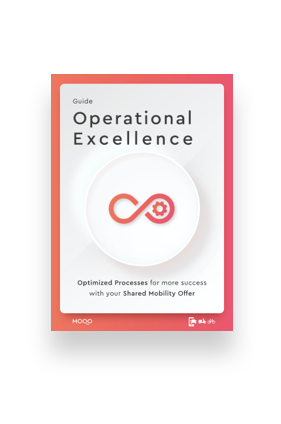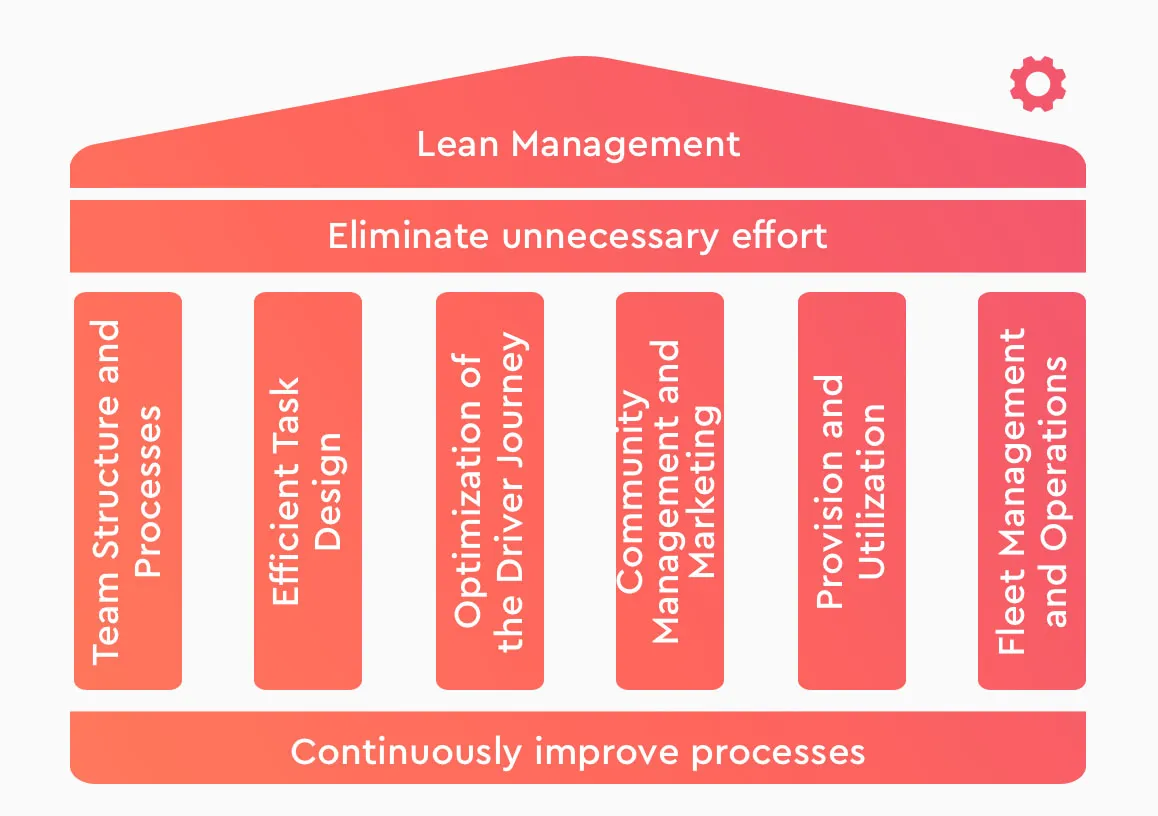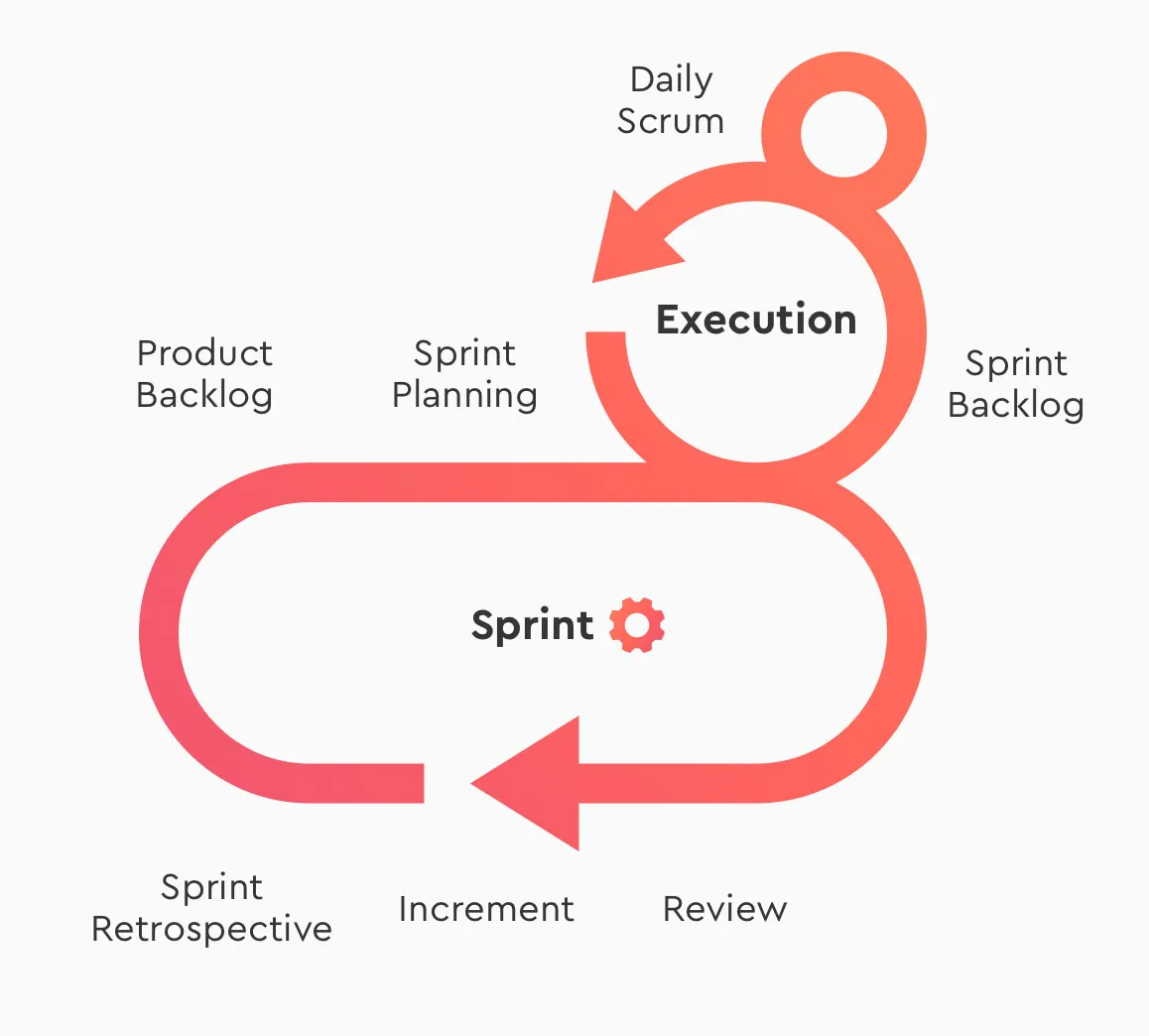
7 min read • October 21, 2021
The declared goal of Operational Excellence can only be achieved if leading tools and methods are applied in everyday work. As a sharing provider, you may be able to leverage already proven corporate practices. Some practices can be integrated without turning the existing corporate structure upside down and for others it requires at the very least a changed mindset of all employees.
Education
Operational Excellence for shared mobility providers can be achieved through three complementary management approaches: Continuous Improvement (Kaizen), which promotes a culture of gradual, employee-driven enhancements using the PDCA cycle; Lean Management, which eliminates waste and aligns processes with customer value—applying techniques like 5S, Kanban, Just-in-Time, Right First Time, and Poka-Yoke—across six operational pillars such as team structure, driver journey, and fleet operations; and Agile Methods, which offer flexibility and responsiveness through practices like SCRUM, Kanban, design thinking, and user stories. These approaches aren’t mutually exclusive and should be adopted selectively based on organizational structure, customer needs, and market dynamics, guiding providers to steadily embed optimization into everyday workflows.

Not every organization follows a particular management philosophy in its work processes and internal collaboration. Instead, processes are often based on individual decisions and routines. In making the decision to use a specific management philosophy, rethinking and restructuring is necessary. If this effort is pursued consistently, it is rewarding and worthwhile.
Although different approaches have different emphases, they share fundamental goals and effects. These include:

The first step is the most difficult in most change management processes. Start by appointing the responsible team members who will take the lead on restructuring as well as who will be the first to attend seminars and training on the various corporate practices.
Follow the guiding principle that organizational development is a marathon, not a sprint. It doesn't matter how big your steps are, it only matters that you take some. Change and optimize your processes one step at a time and include all employees through regular feedback evaluations.
The three approaches below are examples of business philosophies and practices which lead to Operational Excellence for sharing providers.

This guide offers an easy introduction, extensive knowledge, best practices, tips & tricks.
In 43 pages, you'll learn how to perform better with your team and add value to your offerings.

As the name suggests, the Continuous Improvement Process (CIP) is a constant effort to improve one's own service or work processes. In contrast to innovation, where development occurs rapidly, changes within the framework of the CIP happen in continuous small steps.
A term often used synonymously is Kaizen. Kaizen is derived from Japanese and means "change for the better" (Kai = change; Zen = for the better). The origins of Kaizen lie in the Japanese automotive industry. After the end of World War II, the method helped the Toyota company become one of the largest automobile manufacturers in the world.
Kaizen is now a widespread management philosophy. All employees are encouraged to make suggestions for improvements in order to continually increase the quality of the product, service and/or processes. Within so-called ‘Quality Circles’, employees at all hierarchical levels reflect on processes in the company and uncover existing potential for improvement. The key to the success of Kaizen is having a mindset of optimization and step-by-step improvement among all those involved.
Kaizen increases employee satisfaction because they feel actively involved in the company's development which in turn betters the cooperation within a team. Furthermore, because the focus is on the best possible end result and optimization of internal work processes, better profitability and higher long-term productivity of the company is ensured. While some improvements show immediate, visible results, others reveal their value only in the long term. Fundamental to the philosophy of continuous improvement is that every small change for the better makes an important contribution to the big picture. In particular, small changes in internal collaboration often have no direct impact on the service, but can be measured later, for example, in lower costs.
An important tool in the Continuous Improvement Process is the PDCA-Cycle, also known as the Deming- or Shewhart-Circle based on the names of its inventors. PDCA stands for the four following steps:
This cycle is run through again and again. In this way, processes and products are optimized and improved in small, continuous steps.

Lean Management also originated from the Japanese automotive industry and is based on Kaizen. Starting as a method for "Lean Production", it is now applied as a holistic management philosophy in all areas of a company.

“Perfection is achieved, not when there is nothing more to add, but when there is nothing left to take away.“
Antoine de Saint-Exupéry
Lean Management is often understood as solely a method for cost savings. This understanding, however, does not do it justice, as another central aspect is overlooked. Customer orientation is just as important to Lean Management and this means every process or sub-process should be aligned to the needs of the users.
With the help of structured and efficient processes, a company avoids waste, a higher error rate and unnecessary costs and at the same time, offers the highest possible value for the customer. Lean Management clearly fits into the pursuit of Operational Excellence, which means customer value is the target figure to which the entire value chain is aligned, processes and workflows are the focus of action and the shared desire for optimization and perfection is the basis.
Examples of waste are:
In order to minimize such types of waste in the future, the first step is to determine the relevant figures, data and facts. Then, with the involvement of all employees, seek out the methods and possibilities which can make processes more efficient. Lean Management is especially applicable to recurring processes.
Like Operational Excellence, it describes a philosophy or corporate culture rather than a specific method. Instead, processes and tools based on Lean Management are used. These are, for example, 5S, Kanban, Just in Time, Right First Time, Poka Yoke, etc. The problem at hand determines which of these processes can be used.
OPEX: The path to shared mobility success ⟶
Lean Management agrees that standardization is not always applicable as there is no one right tool for every business situation.
Consistently aligning the company with the notion of streamlining encourages a dynamic culture that continuously seeks improvement and focuses on solutions, performance and recognition.
In Shared Mobility, Lean Management is based on six pillars, which can be used as starting points for the effort to optimize processes and in turn avoid waste.
Team Structure and Processes: How is the team structured? How does the cooperation in the team work?
Efficient Task Design: Who is responsible for what? How are individual work processes structured?
Optimization of the Driver Journey: Which (critical) interfaces do drivers pass through from the booking decision to the conclusion of the booking?
Community Management and Marketing: How do potential drivers become aware of the service? How are they bound to the own offer?
Provision and Utilization: Which vehicle types are offered? At which locations? At what rates?
Fleet Management and Operations: What happens in the event of damage? When is the vehicle cleaned? How is it serviced?
All about Operational Excellence in Shared Mobility ⟶

Today's corporate environment is subject to major changes and fluctuations due to digitalization. The mobility industry is also subject to these changes. In order to be able to react more flexibly, proactively and adaptively, more and more organizations are integrating agile working methods into their corporate management.
Agility means that problems are tackled in a timely manner and solved flexibly, instead of relying permanently on existing and conservative forms of operation. This is particularly important in areas that are subject to high fluctuations and constant change. Important requirements for ‘Agile Working’ are constant learning and further training of all employees as well as regular feedback from both employees and customers.
There is no correct answer to the question of whether an organization should use agile or classic methods for project management - the influence of dynamic developments is too varied. Agile is rather a supplement to classic process management than a replacement for it. As a sharing provider, take a close look at which areas of your business can benefit from agile process management and which you can continue to run classic processes.
Important tools in agile process and project management are SCRUM, Kanban, design thinking and personas or user stories.
Originally, SCRUM came from software development, but it is now used in project management. The method provides a framework in which a team can solve complex tasks and requirements and deliver the best possible result.
The entire project duration is divided into smaller units, so-called sprints, which contain fixed, recurring events such as sprint planning, daily scrums, the sprint review and sprint retrospective.
Self-organization and interdisciplinarity of a team are elementary features of SCRUM.
Artifacts: Artifacts are tools and techniques that are used to organize the work and are necessary for an efficient project process. Specifically, these are the Product Backlog, the Sprint Backlog and the Increment.
Rules: The rules define the interactions between roles, events and artifacts.
Events: Each event has specific rules regarding form, frequency and content and is used for communication between roles and project members.
Roles: The specific tasks of a team member are defined through the roles. Each role in SCRUM has its own set of tasks, rights and duties. Important roles are the SCRUM Master, who acts as moderator and contact person, and the Product Owner, who represents the user group.


Which of the management approaches is easiest for your organization to integrate and leads to the desired results is difficult to say. The methods presented are not mutually exclusive and can be combined as necessary. You may have different areas of your organization which require different tools.
When choosing the appropriate method(s), take into account the structural requirements of your organization, your current weaknesses, the needs of your customers and the situation in the local mobility market. There is not only one path to Operational Excellence, but many different ones - find the path that best suits you.
Best Practice: OPEX at Bilkollektivet ⟶

Download our free comprehensive guide about OPEX and learn how to bring your internal processes and operations to the next level.